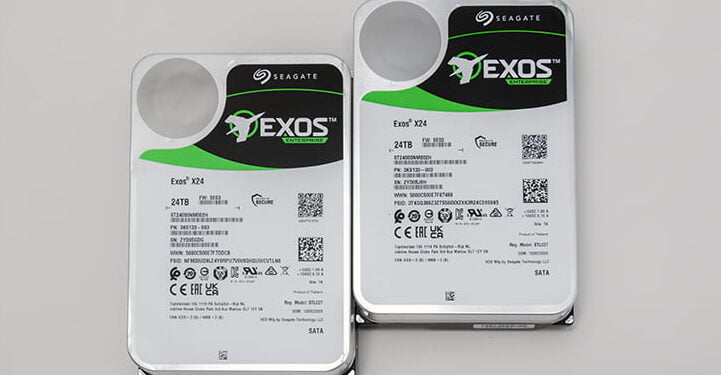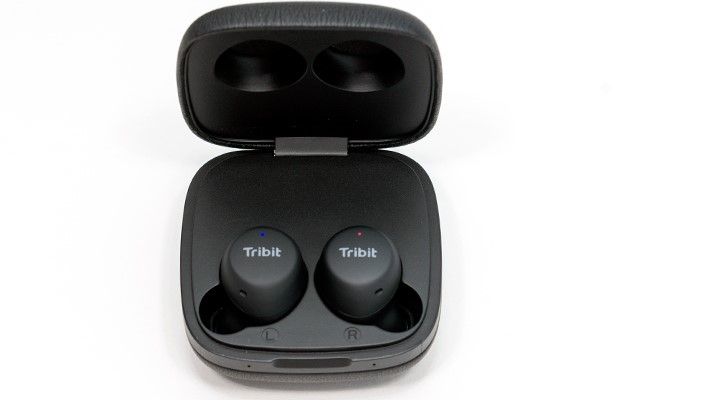
(image courtesy of wikipedia.org)
The other (known) option is to instead of cutting all (for example ten) platters up into data + super tracks on all (ten) platters… the controller can dedicate a full platter (or platters depending on ECC size) just for the parity data. The upside to this method is faster completion of writes (as the parity ‘super blocks’ are written at the same times as the data blocks and thus no second and separate write operation occurs) but this would come at the expense of sequential r/w speed… as a full platter and its r/w arms are basically not being used for data read/write operations. Rather that platter and arm is just being used to write the ECC information… and only read from it when things go sideways. To imagine this operation in action, instead of imagining a Raid 5 array. Think of it as the odd-ball RAID level 3 or even 4 just with the dedicated parity disk being a dedicated parity platter (aka a surprising sane way to implement an insanely temperamental RAID design).

Seagate is mum on which Super-Parity option they use (and if they even use either option)… but the second method would neatly explain why sequential r/w performance has not increased for their PMR/CMR drives since Super-Parity was implemented on the Exos X line… but has increased for the other SMR based series (e.g SkyHawk AI 24TB now rocks the same sequential speed as that of both the IronWolf Pro 24TB and Exos X24 models). Which is highly suspicious. Aerial density has improved for both PMR and SMR based models year after year, and reading from overlapping tracks is more computationally intensive than from a non-shingled track layout (I.E. ‘everyone knows’ that SMR is supposed to be slower than PMR/CMR drives).
Interestingly enough, the patent does specifically mention Shingle Magnetic Recording for the dual write operation method. Specifically, the graphic (figure 1 and 3 in the patent) show that the data tracks are laid down on tracks that do not overlap each other and then the Super-Parity track is written in-between these tracks on to the overlapping ‘shingle’ track. Or to put it another way, Super-Parity configuration turns a SMR layout into a hybridized PMR one where the overlapped data is rarely read from as it is just for parity… and kind of turns a terribly bad idea for track layout into a rather interesting one.

As such, our personal S.W.A.G regarding what Seagate does is that the patents go over multiple methodologies for implementing Super-Parity for a very good reason. Seagate uses different options depending on the underlying technology used in said series and what said series main focus is. I.E. one of the options is mainly for PMR/CMR based drives and the other is used and for SMR drives… but if a given series is more write performance orientated the firmware team will ignore the rule of thumb and use what is best for a given series. Thus helping to alleviate some of SMR’s classic performance issues while at the same time helping CMR drives random read IOPS performance. This could also explain why Seagate went to a multi-head design and why it has not really lived up to the theoretical r/w performance gains that it should have had… as it did. Seagate just used the increase in performance, also mentioned multiple times in the patent, for Super-Parity instead of useless marketing pamphlet specifications.
Regardless if they are using method 1 or method 2 for Super Parity block creation (or some super-secret squirrel combination of both…or even neither) , one thing does remain the same. That is the controller gives these super blocks a secondary parity ECC stripe when they are written. Meaning that the data stored on the rest of the tracks is protected not once, but twice (i.e. there is two chances to recover data from corrupted sectors instead of the usual one). Going back to our RAID analogy this doubling up on ECC almost makes this more a RAID 6 configuration rather than RAID 5… and neatly explains why Seagate can consistently claim no reduction in Non-recoverable Read Errors per Bits Read even though areal density has increased year over year.
As an aside when HAMR + SMR (and its 3/4/5TB platters) gets out of beta channels and into retail channels it would not surprise us in the least if it does take Super Parity idea and use a configuration that is more RAID 6 in nature (dual parity stripes/ Super-Parity tracks backstopped by low level parity ECC data protecting those Super-Parity data blocks). After all, with (just) 3TB platters the size of the proprietary blend of Pt+Fe used to record a single bit of data is going to be only (in Seagate’s own words) “a few nanometers in size”…. and thus the chances of corruption overwhelming even their standard Super-Parity configuration dramatically increases with every areal density increase. Which also neatly explains why they are swapping out their (inexpensive) tried and true (if relatively low power) 28nm dual core ARM SoC for a custom 12nm RISC-V based SoC that will be clocked at 4GHz.

Now with all that said, not everything is sunshine and lollipops. Yes. Seagate has been able to keep the non-recoverable read error rating the same even as bit size has dramatically decreased. However… the number of bits on a drive has increased year over year. One read failure for every 10E15 bits (aka .125 Petabyte aka 125TB) is the same as saying that (statistically speaking) for every 5.208 Full Drive Reads you can count on a bit being wrong and not recoverable. Compare and contrast that with the X22s 5.682 FDR, the X20s 6.25 FDR… the X16’s 7.8125 FDR and this downward trend must be stabilized before we see 40/50/60TB drives be taken seriously by the Enterprise consumer… as at some point even Raid6 will not be able to keep up with the potential for data corruption.
The other ‘downside’ to all EXOS models is that their firmware has been heavily optimized for RAID scenarios, not home environments. The most obvious is the reduced time it will spend on ECC error recovery before it stops and asks the ‘raid controller’ to repair a bad bit/block/etc. Western Digital calls this feature TLER (Time Limited Error Recovery), Seagate calls it ERC (Error Recovery Control). Basically anything business, enterprise, or intended to be used in a RAID environment will have this time limited ECC set to a shorter period of time than on a home user model. Typically it is in the 7 or 8 seconds(ish as it varies from model to model and manufacture to manufacturer) range. Once upon a time you could manually configure the TLER/ERC. These days… not so much as changing the firmware is not for the faint of heart and if something goes wrong with their tool they are on the hook for the replacement costs. We are not going to show you how to mod a drives firmware to do so. We typically do not bother these days. Your Mileage May Vary.
So what happens when this timer goes ping! and stops the ECC recovery process? Well since you probably do not have a RAID controller in your home PC system… the OS pukes out and marks whatever file that bad sector was part of as corrupted. This sounds scary but with modern ECC and modern controllers our personal opinion is that if it takes more than a couple seconds to recover it… it probably is not going to recover it no matter how long the ECC tries. This is why RAID controllers rarely bother with letting the drive’s controller and drive level ECC deal with it. Instead, they almost invariably move to the RAID parity stripe and its ECC to recover it when asked to do such a thing. Since you will not have that parity stripe(s) to fall back on, keep a second copy of anything important on the drive somewhere else. Preferably in a grandfather/father/son backup routine and another copy on your NAS… just as you should be doing already with any important data. After all, if a file is important enough to make you see red if it becomes corrupted it is important enough to be backed up in multiple locations. That is the optimal answer to concerns over ERC/TLER… and quite honestly is going to be a non-issue for the vast majority of people and drives used in a home environment
In either case, when you mix in some low-level tweaks to the MTC formula you have a good idea on what Seagate has done in order to create the X24. To put it another way, while not much has changed compared to the X22 generation what has changed is mostly for the better… and ‘older’ ideas are starting to finally getting the recognition they deserve.










